The New York Sicilian pizza with its thick, springy crust covered in tomatoes, mozzarella, and oregano, is iconic in every sense of the word. Found in nearly every pizzeria in the New York metro area, this pizza packs a flavorful punch and is adored by millions. Our step-by-step instructions show you exactly how to achieve a pizzeria quality Sicilian pie in your home oven.

What makes a New York Sicilian?
Perhaps the best way to answer this question is to start with what a New York Sicilian is not.
Often confused with a true Sicilian pie, known as Sfincione, the New York-style Sicilian is different.
Sfincione is made with a few key ingredients that are not found on a NY Sicilian: breadcrumbs, anchovies, caciocavallo cheese, and an onion-based sauce.
Sfincione was likely the muse for the NY Sicilian, but they are in fact two different styles of pizza.
A New York Sicilian is known for its thick airy texture and crisp bottom. It is often parbaked in a rectangular pan, then topped with a simple sauce of uncooked tomatoes and salt, block mozzarella cheese, Sicilian oregano, and Pecorino Romano.
This is the type of pizza you’d get if you walked into any New York area pizzeria and ordered “a slice of Sicilian”.
Sicilian pizza, New York style is heavier and more filling than the classic New York round pizza.
Step by step New York Sicilian pizza instructions
Each number corresponds to the numbered written steps below.
Note: Mass measurements will always be more accurate than volume measurements. For doughs and bread, this is a good thing because it provides absolute consistency. I only use mass measurements for baking/dough recipes and always stick to standard cups, tablespoons, etc. when “cooking”. But, I also provide the volume (standard U.S. customary) measurements here and in the recipe card below.
Note 2: Baker’s percentages will allow you to scale the dough amount up or down depending on how much you need. To use baker’s percentages you simply divide the amount of flour in a recipe by 100 and then multiply that number by the percentages listed right below.
Bakers Percentages: 64% hydration, .4% yeast, 2% salt, 3.4% oil, 1.2% sugar
- In a mixing bowl, combine 497 grams (~4 cups) bread flour, 2 grams (1/2 teaspoon) instant dry yeast, 6 grams ( ~1 1/2 teaspoons) sugar, and 10 grams (~1 3/4 teaspoons) fine sea salt.
- Place 318 grams (~1 1/2 cups) of cold water into a very large mixing bowl. Add the dry ingredients into the water and mix together with a wooden spoon to form a rough shaggy dough. Drizzle 17 grams (1 1/2 tablespoons) of olive oil onto the dough and mix once more, scraping the sides of the bowl to remove all of the dried bits.
- Place the rough shaggy dough onto a work surface and begin kneading. Knead the dough for 5-7 minutes. If the dough is too sticky, place a clean bowl inverted over the dough and wait for 30-45 minutes before resuming.
- Return to kneading (just make sure to knead for at least a total of 5-7 minutes). Once adequately kneaded, cover for 40 minutes longer, then create a ball. To create a dough ball, pull the dough towards its end repeatedly to form a smooth ball. Pinch the seam side and place the dough ball seam side down into an oiled bowl (a plastic bowl with 1-2 teaspoons of olive oil is best) and cover tightly with plastic wrap. Refrigerate for at least 12 hours but preferably 24 -72 hours before using.
- On the day you make your pizza, remove the dough from the fridge for 1 hour, leaving it still covered. Pour a 1/4 to 3/8 cup of olive oil into a 14-inch square Sicilian pizza pan. You can also use any pan that is roughly the same size. Place the dough ball into the oiled pan and begin pressing it out with your fingers. The dough will not be able to be stretched on the first try. Cover the pan with plastic wrap and let the dough warm up for 30-45 minutes and try to stretch again.
- On the next attempt, the dough will be much easier to stretch with your fingers.
- Cover one more time and the dough will continue to fill the pan. If it doesn’t, just press it out with your fingers and cover for another 45 minutes.
- In pic 8 above the dough has now filled the pan after 3 intervals of pressing and covering.
- In a bowl, mix a 1/2 teaspoon of kosher salt with 1 28-ounce can of crushed plum tomatoes. Spread 4-6 ounces (just a very thin layer) of the tomato sauce onto the dough, leaving the last 1/2-inch without tomato, then cover with plastic wrap. Place the pan on top of the oven or near a sunny window to warm and rise for 3 hours. Note: If the tomatoes seem a little watery, drain them in a fine-mesh strainer for a few minutes.
- Preheat the oven to 430f and set one rack to the lowest level and another in the top 1/3 of the oven. In pic 11 you can see that the dough will have risen substantially over the 3 hours.
- Bake the pizza on the lowest level for 12 minutes. After 12 minutes the pizza should be golden brown on the bottom. Check it out to see! If the bottom of the pizza is still blond you will need to cook it for the remaining time on the bottom level. Otherwise, the remaining cooking time will be on the higher set rack.
- Spread out 12 ounces of shredded low moisture whole milk mozzarella, leaving the last 1/2-inch or so without the cheese.
- Place diagonals of the remaining sauce on top of the cheese. Bake the pizza for 12 more minutes on the higher set rack.
- Remove the pizza from the oven and sprinkle with 3 tablespoons of grated Pecorino Romano.
- Also, sprinkle 1 teaspoon of Sicilian oregano all over the top. Return the pizza to the oven for 1 more minute. If you want a bit more color, broil for 30-60 seconds but watch carefully. Once the pizza is finished cooking, remove it with 2 spatulas and place it onto a wire rack for a couple of minutes. This will keep the bottom crispier and will then allow you to transfer it to a cutting board to cut with a pizza cutter. After cutting into squares the pieces can be placed back in your pizza pan. Enjoy!
The pan for a NY Sicilian
Many pizza shops use heavy black steel pans for their Sicilian pies. Pizzerias utilize a deck oven which browns the bottom of the pizza quicker.
Most homes aren’t equipped to replicate this, however, a pizza steel that’s as large as your pan might be able to simulate the process.
But without a large pizza steel, I would not recommend using a heavy black steel or cast iron pan as it will not allow the bottom of the pizza to brown enough.
I recommend using an aluminum pan since it’s thinner and allows the bottom of the pizza to crisp when placed on the lowest level of the oven. Be sure you watch to prevent the bottom from burning.
A dark aluminum pan like the one pictured above works incredibly well. It’s a LloydPans 14 x 14″ Sicilian pizza pan. It is deep enough for this type of pizza and also works well for focaccia.
You can also use a standard aluminum sheet pan with great results but you might want to increase the dough ball to about 40 ounces versus the 30-ounce used in this recipe. A 30-ounce dough ball will yield a thinner pie that will cook in less time – approximately 5 minutes.
Note: Don’t ever slice your pizza while it’s in the aluminum pan as it can be easily damaged. Instead, move the pizza to the wire rack first, then to a cutting board. Once sliced, you can transfer it back to the pan.
Oven placement and temperature
As you may know, I’ve cooked all of my pizzas in a standard 20-year-old GE oven.
This New York Sicilian pizza recipe has not been tested in a convection oven, so if that is the type of oven you have, you’ll likely need to adjust the cooking time, oven temperature levels, and pan placement.
Note: Many experts state that convection adds 20-25F degrees to recipes that call for a conventional oven.
As mentioned above in the steps, it’s important to check the bottom of the pizza after 12 minutes of cooking. If the bottom is very blond, finish cooking it on the bottom rack for the remaining 12-13 minutes of cooking time.
If you’re having problems with browning, you will have to cook at a higher temperature on your next attempt. Probably towards 450f.
Inevitably, the temperature of all ovens fluctuates. Your oven is not my oven, or your nonna’s oven. You will most likely need to play around with the placement and temperatures a bit.
Just keep in mind that making a New York Sicilian pie is an interactive process and requires some love, attention, and finesse! But I’m confident that with these instructions you’ll be able to make a pizza that looks just like mine (maybe even better!).
Using a stand mixer
While stand mixers can certainly be handy, I prefer to show the process here and on YouTube without any special equipment so it’s accessible to the masses. For that reason, these instructions are for hand mixing.
However, if you’d like to use your mixer, simply follow these instructions:
- Mix dry ingredients in a large bowl and place half of them and all the water into the Kitchen Aid mixer bowl.
- Using the dough hook attachment, mix for 1 minute on low (speed level 1) and begin adding in the remaining dry ingredients.
- Drizzle the olive oil into the mixing bowl and continue at speed level 1 for 3-4 more minutes or until the dough is sticking well to the dough hook.
- Remove the dough and hand knead for 1 minute. Ball it up and place it in an oiled container and cover tightly. Cold ferment the dough for a minimum of 12 hours but if possible, shoot for at least 24 hours and up to 72 hours in the fridge for a better tasting dough.
Why par-bake a New York Sicilian pizza?
This type of pizza differs from other New York-style pizzas in that it requires par-baking. That is baking the dough with very little sauce prior to adding the cheese and remaining sauce. A few benefits to par-baking include:
- Increased oven spring. Basically, you’re locking in the size of the pizza, getting more airiness in the crust, and preventing all the sauce and cheese from penetrating the dough and making it too soggy.
- Pre-saucing. The sauce helps keep the moisture level intact and prevents very large bubbles from forming. I also think it helps the next layer of cheese and sauce grab a bit better and not fall off when eating.
- Make ahead. You can save the par-baked pizza crust plastic wrapped in the fridge for up to 3 days. Once you want to make a pie, the process will be so much easier. This is what many pizzerias do to speed up their workflow.
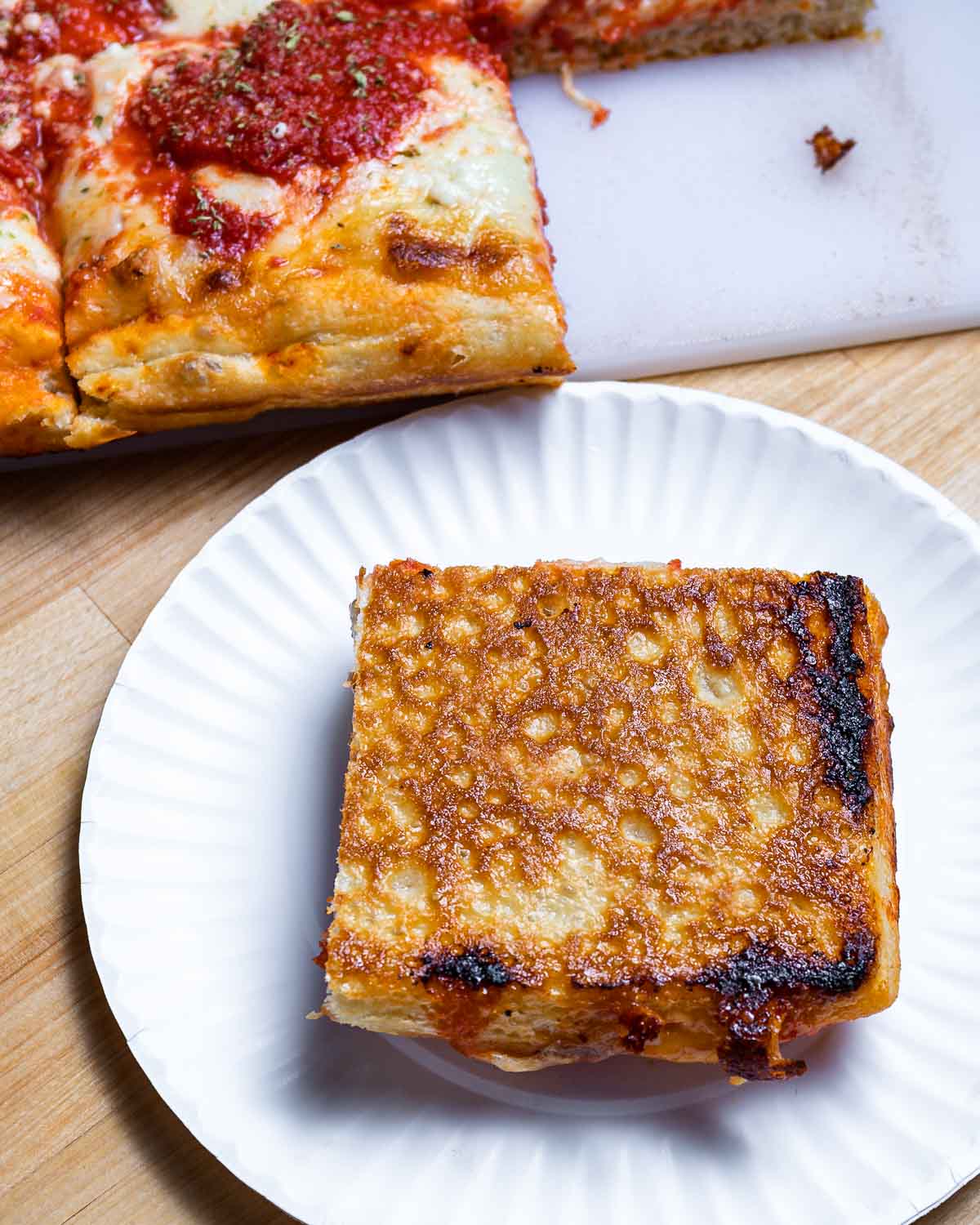
More great pizza recipes
- New York pizza – The classic round pizza cut into triangular slices – the kind you’d find at every legit NY pizzeria.
- Grandma pizza – The Long Island classic. Thinner than a NY Sicilian with lots of garlic.
- Vodka sauce pizza – Sheet pan style with the most delicious vodka sauce and basil.
- Pizza fritta – also known as fried pizza dough topped with a variety of savory or sweet toppings.
- New York white pizza – A round pie topped with mozzarella, ricotta, garlic, and a touch of Pecorino Romano.
- Garlic knots – Classic pizzeria-style knots topped with garlic, Pecorino Romano, hot pepper, and parsley.
If you’ve enjoyed this New York Sicilian pizza recipe or any recipe on this site, give it a 5-star rating and leave a review.
If you want to learn more about New York pizza and Jim’s pizza-making journey listen to the Sip and Feast Podcast episode 5.
Some people learn by watching. If you’re that type of person, you can find most of our recipes on YouTube and our Facebook Page.
New York Sicilian Pizza

Ingredients
For the dough
- 497 grams bread flour or 4 cups
- 2 grams instant dry yeast or 1/2 teaspoon, SAF brand recommended
- 10 grams fine sea salt or 1 3/4 teaspoons
- 6 grams granulated sugar or 1 1/2 teaspoons
- 318 grams cold water or 1 1/2 cups
- 17 grams olive oil or 1 1/2 tablespoons, plus more for proofing container
For the NY Sicilian pizza
- 1 30 ounce dough ball from above recipe
- 1/4 cup olive oil
- 1 28 ounce can crushed plum tomatoes drained
- 1/2 teaspoon kosher salt
- 1 teaspoon Sicilian dried oregano or Italian oregano
- 3 tablespoons Pecorino Romano grated
- 12 ounces low moisture whole milk mozzarella shredded
Instructions
For the dough
- Place water into a bowl large enough to hold both the water and all the dry ingredients and still have room to spare. Mix together dry ingredients in another bowl.
- Add dry ingredients to water a bit at a time and mix thoroughly to form a dry rough mass. Pour the oil over the dough, mix again, and place the rough shaggy dough onto a work surface.
- Knead the dough for 5-7 minutes. If the dough is too sticky, place a clean bowl inverted over the dough and wait for 30-45 minutes before resuming. Return to kneading (just make sure to knead for at least a total of 5-7 minutes).
- Place the bowl over the dough once more and let sit for 30-40 minutes to warm up before forming the dough ball.
- After 40 minutes pull the dough toward its end repeatedly to form a smooth ball. Pinch the seam side and place the dough ball seam side down into an oiled bowl (about 2 teaspoons olive oil) and cover tightly with plastic wrap. Refrigerate for at least 12 hours but preferably 24 -72 hours before using.
For the NY Sicilian Pizza
- Take the dough out of the fridge for 60 minutes prior to use. Do not uncover the bowl.
- Pour and spread the olive oil into a 14-inch square pan and drop the dough ball into it. Try to stretch with your fingers to fill the pan for a couple of minutes. The dough will not be able to be stretched on the first try. Cover the pan with plastic wrap and let the dough warm up for 30-45 minutes and try to stretch again. If unsuccessful, cover one more time and wait another 30-45 minutes. Press the dough into the corners to form a crust.
- Mix the salt into the tomatoes. Spread 4-6 ounces of the tomato sauce onto the dough (just a very thin layer) then cover with plastic wrap. Place the pan on top of the oven or a sunny windowsill to warm and rise for 3 hours.
- Preheat the oven to 430f and set one rack to the lowest level and the other to the top 1/3 of the oven. Once the oven is to temp and the dough has risen enough par-bake the pizza on the lowest rack for 12 minutes or until the bottom of the pizza is lightly golden and the dough has firmed up.
- Remove the pizza and top with the mozzarella cheese, leaving 1/2-inch of the perimeter without any cheese. Spoon the sauce on top of the pizza in diagonal lines (you might not need all of the sauce) and cook on the higher set rack for 12 minutes more.
- Remove from the oven and sprinkle with grated Pecorino Romano and Sicilian oregano. Cook for 1 minute more. You can broil the top for 30 seconds or so for more color but watch very carefully! Enjoy!
Notes
- The dough can be cold fermented for as little as 12 hours in the fridge but is much better after a longer period. 24 to 72 hours is recommended.
- If refrigerating the dough ball in a metal bowl use a bit more oil to coat. The metal bowls tend to stick more than plastic.
- Cooking time will vary depending on the exact oven temp. After 12 minutes of cooking on the lowest rack, the pizza should be quite golden. If it's completely blond, the pizza might need further cooking on the lowest rack after adding the sauce and cheese. All ovens are different so you will need to check the bottom to make sure!
- The Sicilian pizza needs a lot of oil. More than you think! The oil helps develop the amazing crispy bottom, so please use enough of it.
- Leftovers can be saved for up to 3 days and the pizza can be reheated at 350f on a baking sheet until hot. About 10 minutes.
Nutrition
Nutrition information is automatically calculated, so should only be used as an approximation.
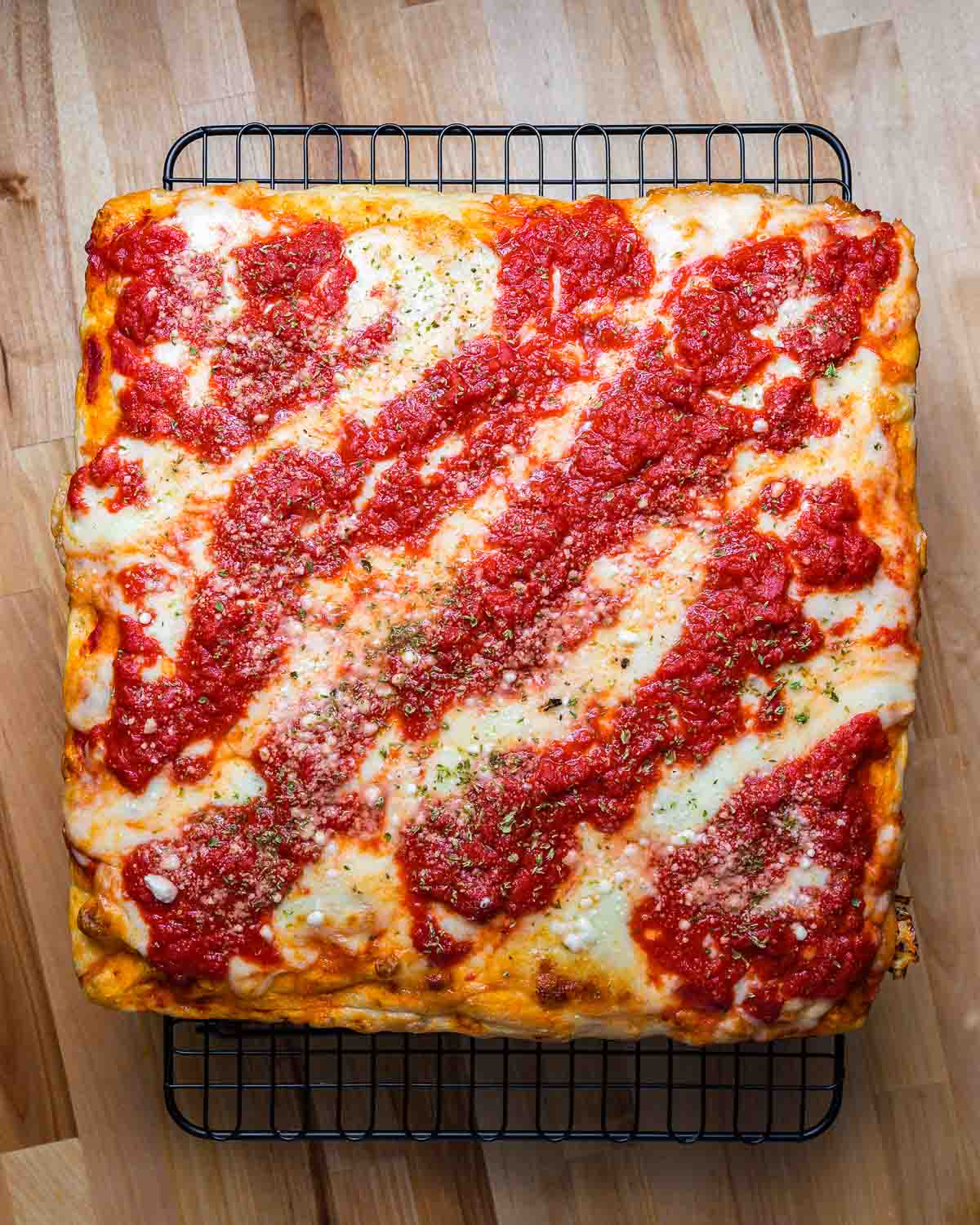
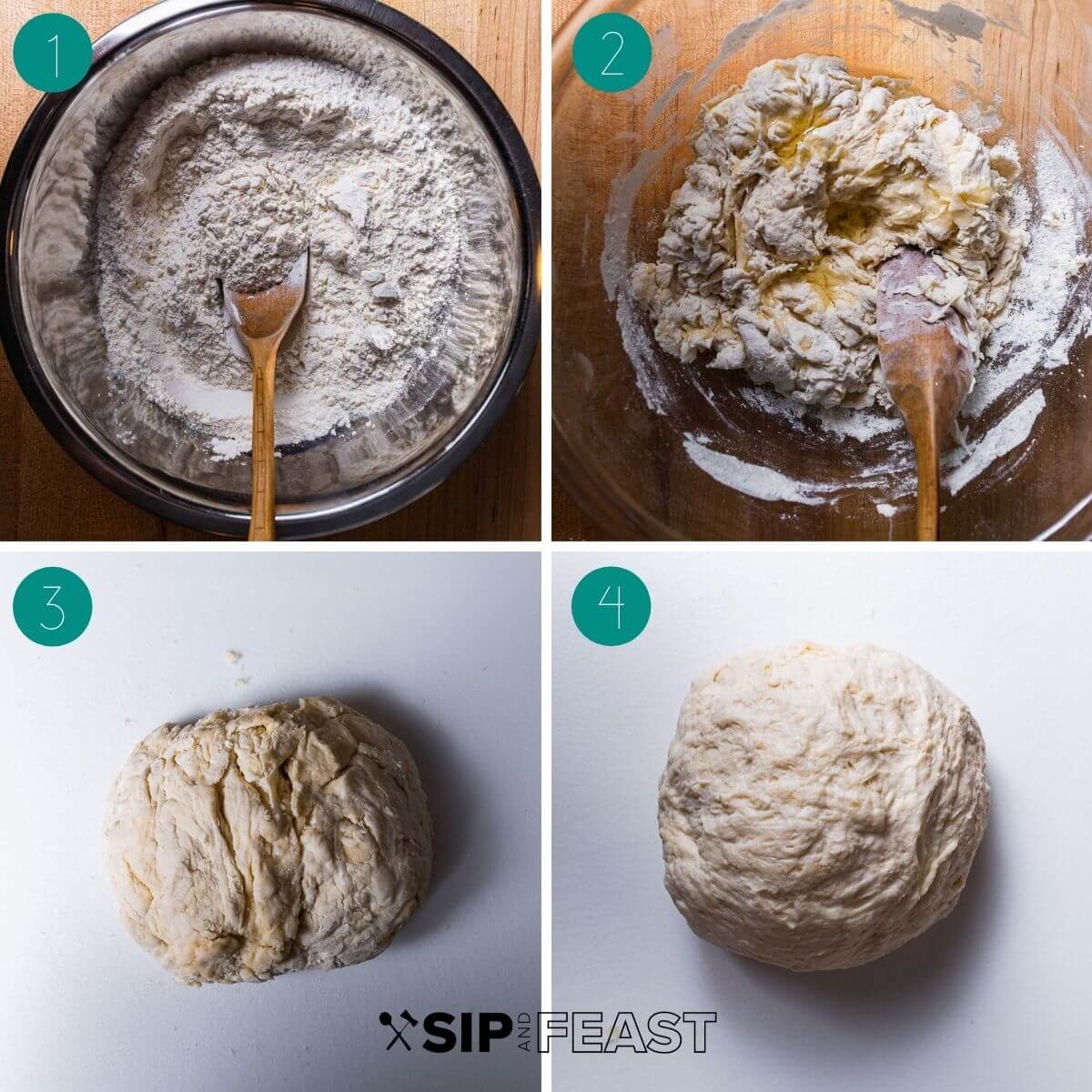
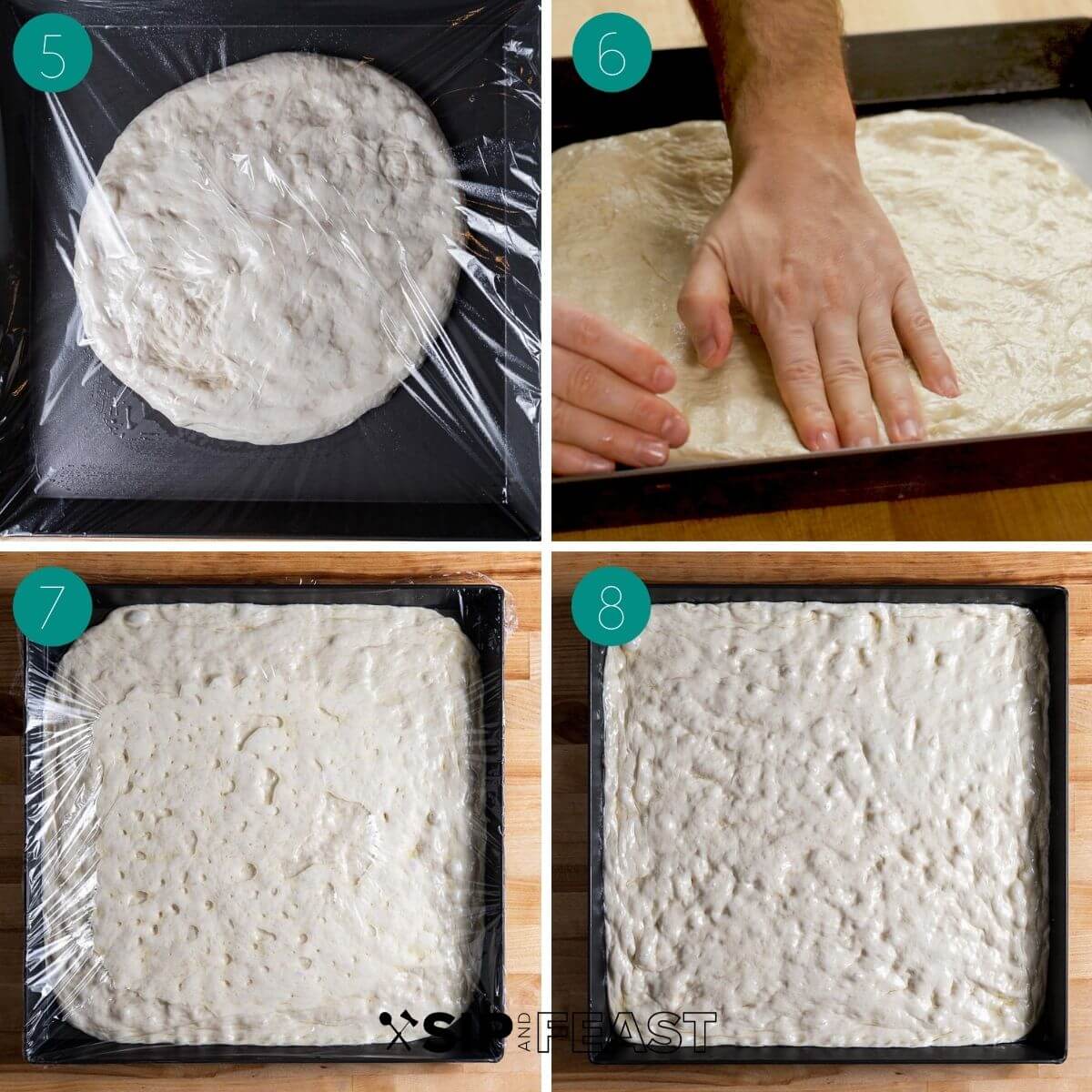
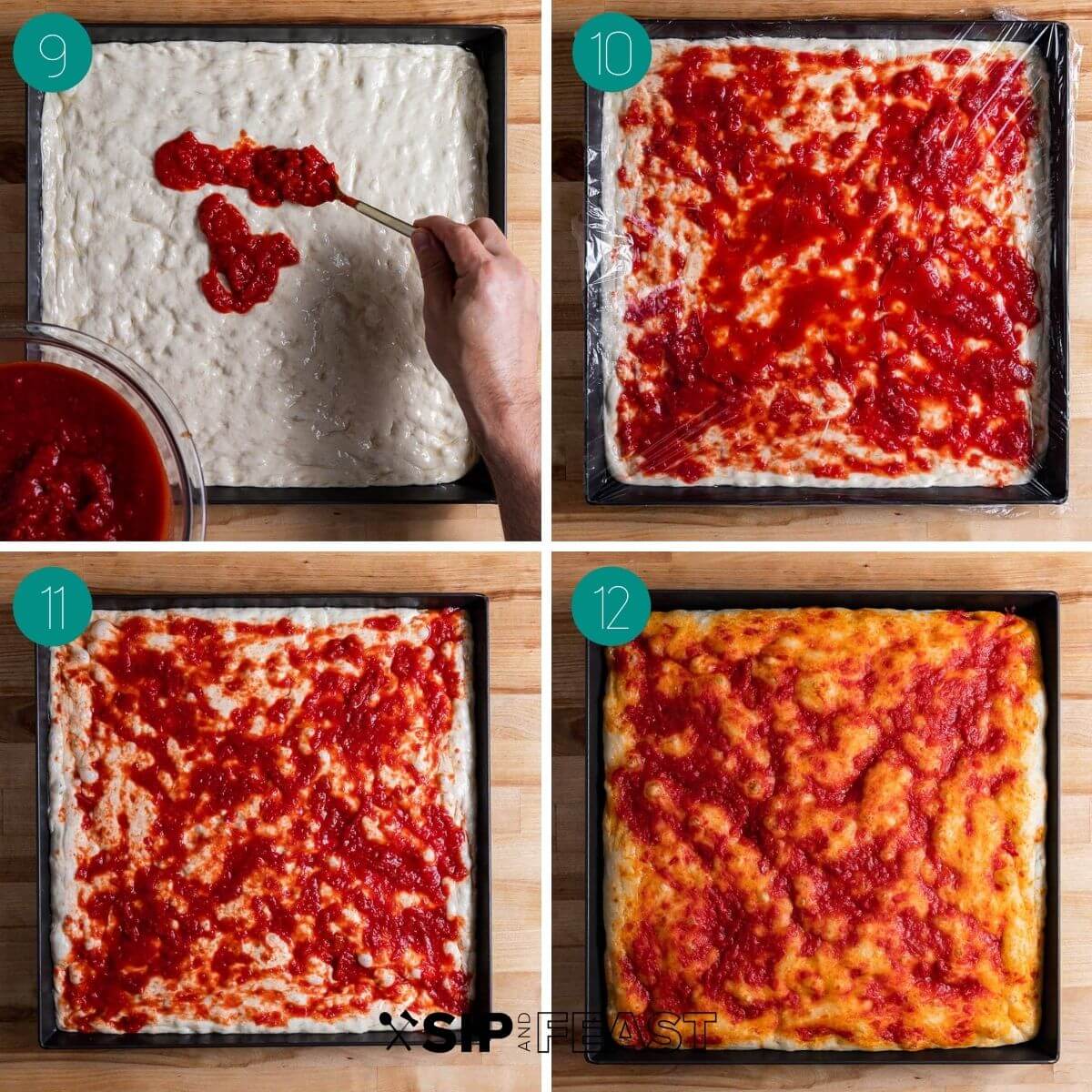

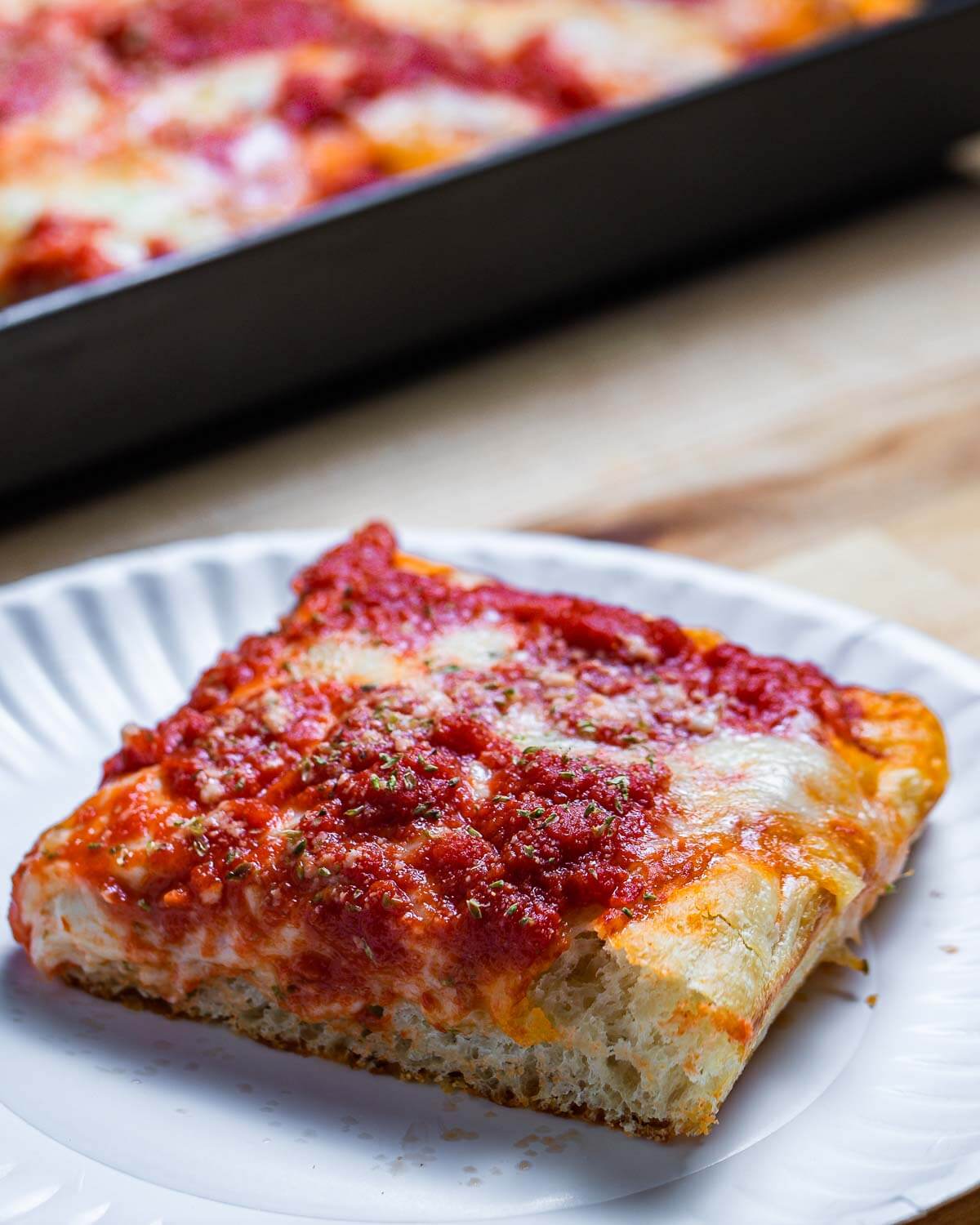
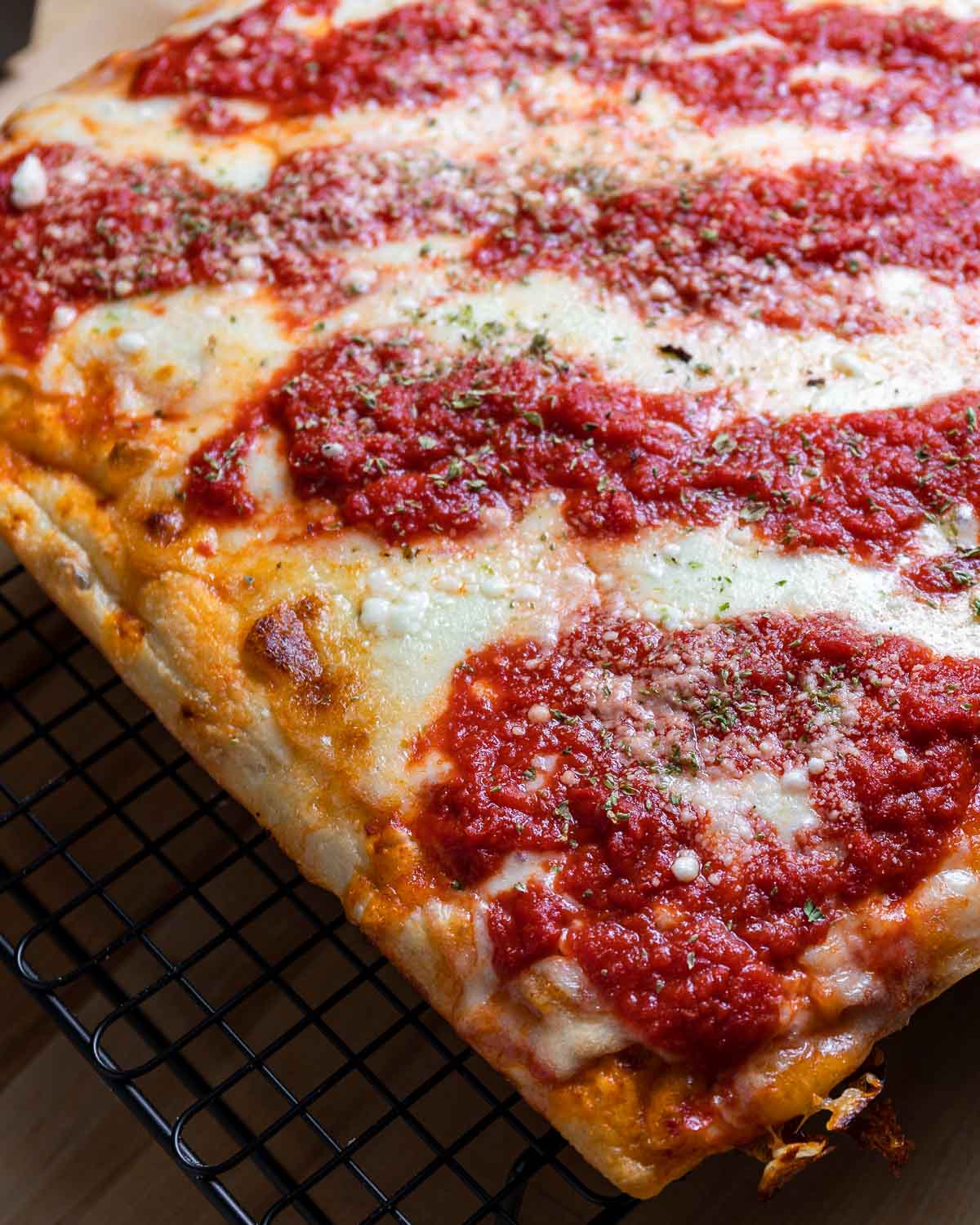







Amazing pie! Purchased some sicilian oregano from amazon, and put some in the sauce overnight. This oregano is fantastic! Pizza making has been my passion my whole life! I managed a Shakey’s Pizza Parlor from 1970 to 1985 and had a love for trying different types of pie. I’m very glad to have found your web site, and enjoy watching your videos and your passion for Italian cooking! Great work, thank you!
Hi Michael, I’m so happy you liked the pizza! Thanks for the rating and really appreciate the comment!
Let me start by saying I’m a pizza loving New Yorker who now lives in Florida. I made this recipe on Sunday and my “NY Pizza Snob” husband LOVED it. He said “this is legit NY Pizza” I’m not sure there’s a better compliment. Thanks for sharing, I will definitely be trying more recipes.
Hi Lisa, this is wonderful to hear and I’m so happy you enjoyed it! That really is a great compliment!
Great recipe, turned out terrific. I topped it with some good spicy salami and everyone loved it. Ty
Hi Paolo, so happy you enjoyed the pizza and really appreciate the comment and rating!
Jim, I hope you can answer this evening. I have cold fermented 2 days and am par cooking tonight and finish tomorrow. You told Rich in another comment that he can store in refrig overnight, bring to room temp then finish either on sheet pan or back in an oiled Sicilian pan. Do I assume then after the par cook I need to take it out of the pan for refrigeration until tomorrow and then either back in oil pizza pan or sheet pan? I was thinking to just keep it in the original pan I prebaked it in but if that’s N/G please let me know. Thank. you.
It should be ok left in the pan.
Can I use active dry yeast instead of instant yeast? If so, what changes would I have to make to the recipe (if any)?
Hi Jeff, you can use active dry. You’d just mix the yeast with the 318g (~1 1/2 cups) of water first. The water should be warmed to 115f. Let it sit until frothy, then add the flour, sugar, salt, etc.
Jim, we love this pizza, I want to treat a group of friends for super bowl. I am either going to do the prebake, refrigerate, finish while group is here. Or, complete the pie, then reheat. If I do this, can it sit out for hours or refrigerate? Also, have you had success reheating, any tips?
Next question, they all love pepperoni. When should I add the toppings and do they go on top or under the cheese/sauce?
Please point me in the right direction, you will get full credit when everyone wants to know where I got this recipe!
Thank you!
Hi Den, you can refrigerate or let it sit at room temp for a few hours. I’d recommend reheating it at 350f until warm or hot. As far as pepperoni, I’d recommend using cupping pepperoni and putting it on top of the cheese. I don’t have a post on my website for this, but I recommend going to my YouTube channel and watching my “3 Must Use Meats For Best Meat Lover’s Pizza”. In this video, you’ll see me use the Sicilian pizza dough and I add cupping pepperoni, sausage, and prosciutto. You’d follow the same process, minus the sausage and prosciutto. Or you can refer to this pepperoni pizza post, but this one uses the Grandma pizza and not the Sicilian: https://www.sipandfeast.com/best-pepperoni-pizza/
Hope that helps!
Jim, thank you for those videos re my pepperoni question, they were clear and informative. I have the 18 x 18 Lloyd pan and used it several times when making your Sicilian. (and the Lloyd 16 x 12 for your Grandma) I always have sticking problems even with full amount of oil. Sometimes the pizza even rips when trying to chisel out. Is there a tip for good release with these pans? I didn’t try parchment assuming that would interfere with the crispiness.
Hi Den, I’ve never had a sticking problem with the pans. As long as you’re using the proper amount of oil there shouldn’t be an issue.
Hi Jim,
When I make my regular pizza, I usually use the warm water (110 degrees) and have my dough rise for 2 hours then another 45. My oven has a proof mode too.
But you do a COLD RISE on your dough, why? I definitely will follow your recipe for this pizza, but just curious.
Also, How long would you recommend kneading in a mixer? I Do not want to Over-knead it. I prefer using a stand mixer, Plus my husband is not patient to wait 2 days for dough-but I guess he may have to “get over it” ..lol
Hi Joanne, the cold fermentation process lends tremendous flavor to the dough that’s simply not achievable otherwise. As far as the stand mixer goes, I go into detail on this in the post. See the section titled “Using a stand mixer”. Hope this helps!
Jim, I decided Not to use my stand mixer. I wanted to do exactly as you instructed. I purchased everything you used too.
I felt the dough a little dry, but it became stickier when I let it sit for another 45 minutes on the second knead. Your written recipe uses fine SEA SALT and in your video you say table salt. Does it matter which one I used? The dough has been in my refrigerator for about 16 hours so far. But I do not see any growth at all. Is something not right? I may have to redo it again and if so , any suggestion I have done something wrong? Or I am getting ahead of myself and need to be PATIENT and wait for the 72 hours-lol.
Hi Joanne, the dough won’t grow much in the refrigerator as the cold slows down the growth. As long as you used the proportions I listed and follow the instructions on stretching, it will all fit in the pan. As far as the salt, you can use table salt or fine sea salt. You just don’t want to use coarsely ground salt, like kosher salt, for this recipe.
Thanks so much for all your answers. I remade the dough and it was exactly as you showed in video( scraggly to sticky)! Apparently, My scale had a bad battery so measurements were not right. But, I still used first batch of dough as Focaccia and it was delicious! Not dry at all. Cannot wait to eat the Pizza now!
Can I keep the dough in refrigerator longer than 72 hours? I May want to eat for Super Bowl Sunday….. I also will tell everyone about your website:)
Thanks and keep cooking!!!!!
Hi Joanne, You can, but I wouldn’t go further than about 4 days. If you want to store dough balls for longer I recommend freezing them. You would simply cold ferment for 48-72 hours then freeze the ball wrapped tightly in plastic for long-term storage. Move the ball to the fridge the night before pizza-making day, then continue with the recipe instructions.
I am a Nee Yorker who love Sicilian pizza. I now live in Florida and cannot find anything that compares. I discovered this recipe and video in October and have gained 10 pounds because this Sicilian is so amazing! Just like I remember! It’s important to use the same sauce used in recipe.
So happy you like the recipe, Michelle, and really appreciate the comment and review!
Jim, this recipe came out perfectly, my husband had a fond memory of Sicilian from his Brooklyn youth. So glad I purchased the pan you recommended.
Can you recommend those long rocker type pizza cutters, there’s a couple on Amazon 16″ and 18″ that I am considering but notice you use the wheel. I keep veering off line when I use the wheel. Have you had any experience with one? I will follow your knowledgeable lead. Thank you.
Hi Den, so happy you enjoyed the the pizza! I have used a rocker before but much prefer the roller. I personally wouldn’t recommend the rocker.
What amount of dough would you use in a 12×12 Lloyd’s pan?
Hi Shirley, you’ll need roughly 1/3 less dough since my recipe is for a 196 sq inch pan and your is 144 sq inches. But the simpler thing to do might just be to make the full amount of dough in my recipe and use the excess dough to make a few garlic knots (see my garlic knot recipe).